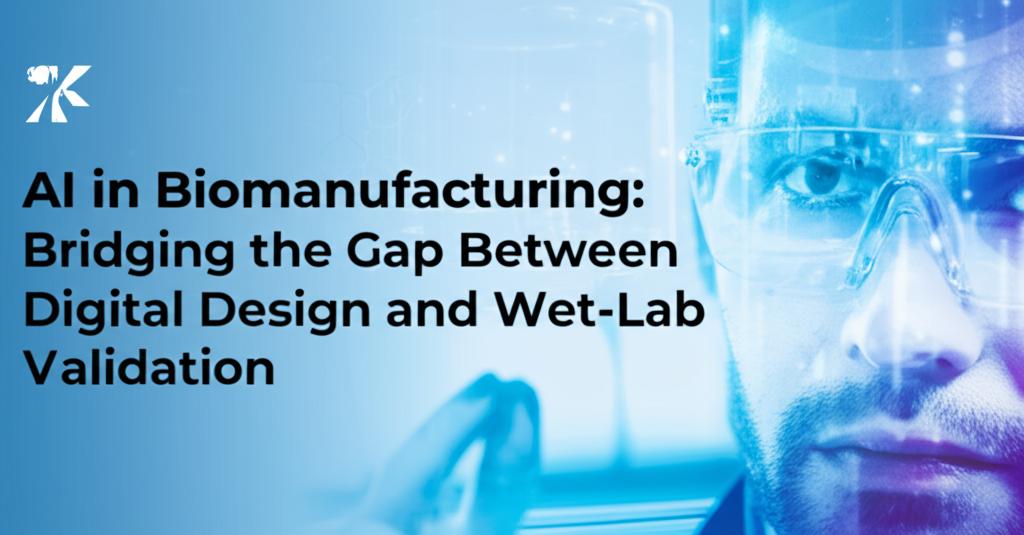Artificial intelligence (AI) is revolutionizing biomanufacturing, creating a powerful link between computational design and physical laboratory validation. This integration is streamlining processes, reducing costs, and accelerating the delivery of life-saving therapeutics.
Accelerating Discovery and Design:AI algorithms are transforming the early stages of biopharmaceutical development. By analyzing vast datasets, AI can identify and predict optimal enzyme designs and synthetic biology workflows with remarkable speed and accuracy. Generative AI models can even design entirely new protein sequences tailored to specific therapeutic needs, such as increased efficacy, reduced immunogenicity, or improved manufacturability. This in silico approach significantly reduces the reliance on time-consuming and expensive traditional trial-and-error wet-lab experiments. Machine learning-powered Design of Experiments (DoE) can cut down unnecessary experiments by as much as 80%.
Optimizing Bioprocesses:In bioprocess development, AI excels at optimizing critical parameters. Traditional methods involve numerous wet-lab experiments to adjust variables like temperature, pH, and nutrient levels. AI-driven bioprocess modeling, including the use of digital twins, replaces much of this manual experimentation with predictive simulations. Digital twins, which are virtual replicas of physical manufacturing processes, allow for the simulation of various scenarios and prediction of outcomes before any physical changes are implemented. AI continuously refines these models using real-time data, creating dynamic and adaptive systems for process optimization. This is particularly beneficial for scaling up production while maintaining product quality. For instance, in fermentation processes, AI can define the ideal set of conditions (the "golden profile") and suggest real-time corrective actions if deviations occur.
Enhancing Quality Control and Automation:Maintaining consistent product quality is a major challenge in biomanufacturing. AI-driven quality control systems continuously monitor production parameters and can predict deviations before they lead to quality issues. This minimizes human error and reduces variability between batches. Furthermore, AI enhances the capabilities of robotics through machine learning and computer vision, enabling robots to adapt to changing conditions, recognize patterns, and make decisions. This synergy between AI and robotics drives automation in various manufacturing stages, from sample handling to packaging, increasing throughput and reducing the risk of contamination.
Bridging the Gap with Wet-Lab Validation:Despite the power of AI in prediction and design, the transition from digital models to functional, real-world products requires robust wet-lab validation. A significant bottleneck remains in this iterative feedback loop between computational insights and experimental results. To address this, the industry is focusing on creating integrated platforms that seamlessly connect AI-driven design with high-throughput wet-lab experimentation. This "closed-loop" integration allows for continuous refinement of AI models based on real-world data, ensuring that the AI-generated designs are not only theoretically optimal but also experimentally validated and manufacturable at scale. Companies are increasingly partnering to combine expertise in generative AI with practical experience in drug development, from target discovery to Investigational New Drug (IND) applications, to create next-generation AIGC (AI-generated content)-driven antibody drug discovery platforms.
The Rise of Digital Twins and "Self-Driving" Labs:The concept of digital twins is becoming increasingly prevalent, allowing manufacturers to simulate and optimize bioprocesses virtually before physical implementation. This reduces errors and enhances efficiency. Looking ahead, the integration of AI with other emerging technologies like the Internet of Things (IoT) and robotics is paving the way for fully automated and self-regulating "smart factories" or "self-driving labs." These futuristic labs aim to automate repetitive tasks, enhance data analysis, and accelerate discovery processes with minimal human intervention.
Challenges and Future Directions:While the potential of AI in biomanufacturing is immense, several challenges need to be addressed. These include:
- Data Quality and Availability: AI models require large, high-quality datasets for effective training and accurate predictions.
- Model Interpretability: The "black-box" nature of some AI algorithms can make it difficult to understand their decision-making processes, hindering trust and adoption.
- Integration with Existing Systems: Incorporating AI into established biotech infrastructure can be complex and costly.
- Regulatory Hurdles: Navigating the regulatory landscape for AI-developed and manufactured therapeutics is an ongoing process.
- Workforce Training: A skilled workforce capable of developing, implementing, and managing AI systems is crucial.
The future of AI in biomanufacturing is bright, with ongoing advancements in machine learning, robotics, and data analytics. As AI-powered systems become more sophisticated and accessible, they will play an increasingly vital role in making biomanufacturing more agile, cost-effective, and capable of delivering innovative therapies to patients worldwide. The collaboration between computational scientists, bioengineers, clinicians, and regulatory experts will be key to realizing the full transformative potential of AI in this field.

